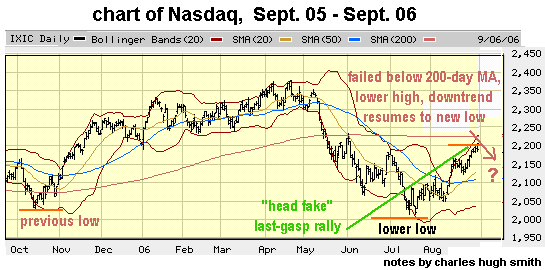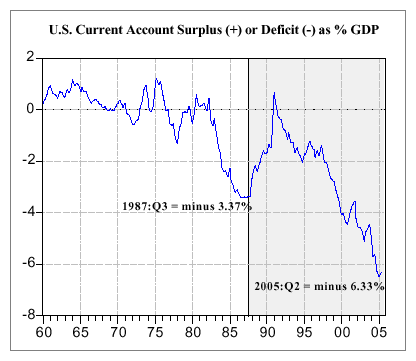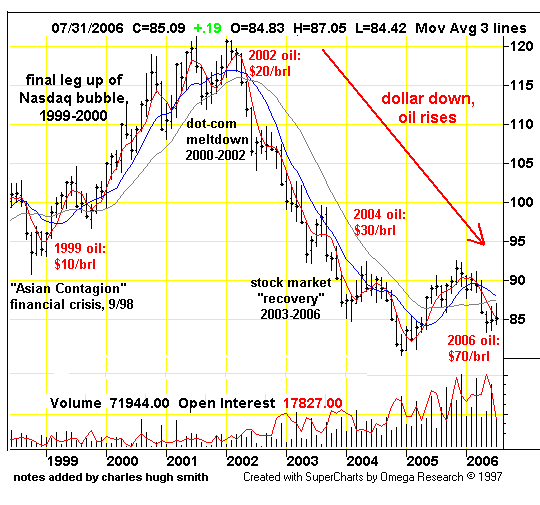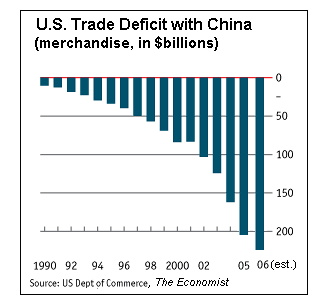

|
| weblog/wEssays archives | home | |
|
Protecting Capital III: The Trade Imbalance and the Dollar (September 7, 2006) Before we get to the dollar, let's take a look at a chart of the Nasdaq. Why? Because the market suddenly discovered the wage inflation I documented yesterday, and promptly dropped. As my notes indicate, this is a critical roll-over, as this "head-fake" rally failed to rise to the 200-day moving average (the thin red line). Note also that the index managed to hit the classic signs of a Bear Market--lower lows and lower highs. 
Does any responsible person actually believe the hocus-pocus line that inflation is benign and will always remain so, now that the Fed has raised rates from a massively inflationary 1% to a still-historically low 5.25%? This chart suggests traders are no longer so sure that Tooth Fairy Fantasy is actually true.  OK, on to the dollar. Why should we care about the relative value of the dollar? Let's
take a look at a chart of how much we as a nation are buying from other countries.
Gee, it seems we're buying about 6% more of our entire GDP than we sell. That works
out to a deficit (imbalance) of about $800 billion. So why do we care? For two reasons:
OK, on to the dollar. Why should we care about the relative value of the dollar? Let's
take a look at a chart of how much we as a nation are buying from other countries.
Gee, it seems we're buying about 6% more of our entire GDP than we sell. That works
out to a deficit (imbalance) of about $800 billion. So why do we care? For two reasons:
1) If the dollar drops in value (depreciates), then the cost of all those foreign goods rises, further fueling inflation. 2) We have to come up with the $800 billion from somewhere, and since we have negative savings (i.e. we spend more than we make), we have to borrow vast sums of money from foreigners in order to buy all these foreign products. Many economists have fretted about this abysmal balance of trade problem, but every year it grows worse without apparent consequences. As a result, complacency reigns supreme: if our current account deficit is so horrible, how come nothing bad ever happens? Well, maybe some day there will be consequences. Like what? Like a massive drop in the dollar. Many financial types reckon that the only way to correct the immense imbalance between what we sell and what we buy from foreign sources is for the dollar to drop so low that we can no longer afford overseas goods, and our goods will become so cheap in foreign currencies that other countries will start buying lots more of what we make (aircraft, soybeans, music, movies, software, etc.) Is this just the concern of fringe doom-and-gloom types? Only if you count Warren Buffett in that crowd. To excerpt my entry from August 30: What could trigger such a devaluation? The final straw is unknown, but the risks, at least to people like Buffett, appear to be growing. For more of Buffett's views, go to the Berkshire Hathaway annual report and scroll to pages 18-25 But as I argued in a November 10, 2003 article in Fortune, (available at berkshirehathaway.com), our country’s trade practices are weighing down the dollar. The decline in its value has already been substantial, but is nevertheless likely to continue. Without policy changes, currency markets could even become disorderly and generate spillover effects, both political and financial. No one knows whether these problems will materialize. But such a scenario is a far-from-remote possibility that policymakers should be considering now. Their bent, however, is to lean toward not-so-benign neglect: A 318-page Congressional study of the consequences of unremitting trade deficits was published in November 2000 and has been gathering dust ever since. The study was ordered after the deficit hit a then-alarming $263 billion in 1999; by last year it had risen to $618 billion. (note: it has since risen to over $800 billion.) 
As oil is priced in dollars, then we also have to consider the effects of a dropping dollar on oil prices. As this chart reveals, the dollar seems to move in a negative correlation with the price of oil: dollar drops, oil rises. There are also a few inherent problems with the notion that we can sell enough stuff to balance out our imports: 1) Some of our most valuable exports (entertainment and software) are easily pirated/copied. 2) Though the U.S. is the second-largest exporter (behind Germany), we simply don't make enough stuff to offset the stupendous quantity of our imports; our primary exports are aircraft, farm equipment, agricultural products, entertainment and software. Not only can we not produce $800 billion more of these goods, nobody needs $800 billion more planes, DVDs, tractors or soybeans. Some look to financial services as our savior, and while that helps, the world doesn't need a half-trillion dollars' worth of U.S. financial services, either. There is a peculiar circularity to the hope that our exporting trading partners can suddenly prosper as their exports to us plummet. Won't those losses push their economies into a slump? And once they're in a slump, why would they need more imports from us? The momentum works in the opposite direction: if the U.S. dollar slips, then imports will be cut, pushing our trading partners into recession--which is unlikely to trigger a buying spree of U.S. goods and services. Bottom line: the only way to re-balance trade is for the U.S. to drastically curtail imports, cutting the sales and profits of our export-dependent trading partners.  3) A large drop in the value of the dollar won't affect our trade deficit with China at all.
Why? Because the yuan is pegged to the dollar. The dollar can rise or fall
against the Swiss franc, the euro or the yen, but not the yuan. Net result: the trade
deficit with China will remain untouched by a dollar devaluation.
3) A large drop in the value of the dollar won't affect our trade deficit with China at all.
Why? Because the yuan is pegged to the dollar. The dollar can rise or fall
against the Swiss franc, the euro or the yen, but not the yuan. Net result: the trade
deficit with China will remain untouched by a dollar devaluation.
Some economists claim that no nation has ever supported a trade deficit larger than 5% of GDP. Since we are well over that line, there is some sense that time is running out on our prodigious trade deficit. So what does an investor like Mr. Buffett do who's worried about the trade imbalance and thus the dollar's value? Well, Mr. Buffett is one example, and he's been buying foreign companies with assets and earnings in currencies other than dollars. For more on this subject and a wide array of other topics, please visit my weblog. copyright © 2006 Charles Hugh Smith. All rights reserved in all media. I would be honored if you linked this wEssay to your site, or printed a copy for your own use. |
||
| weblog/wEssays | home |